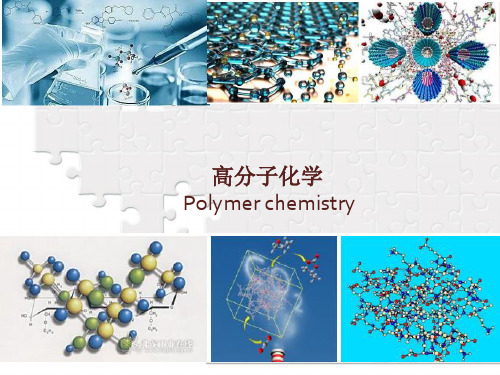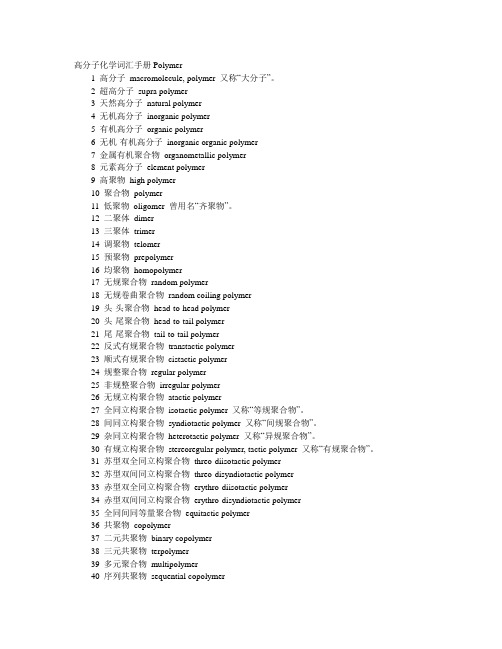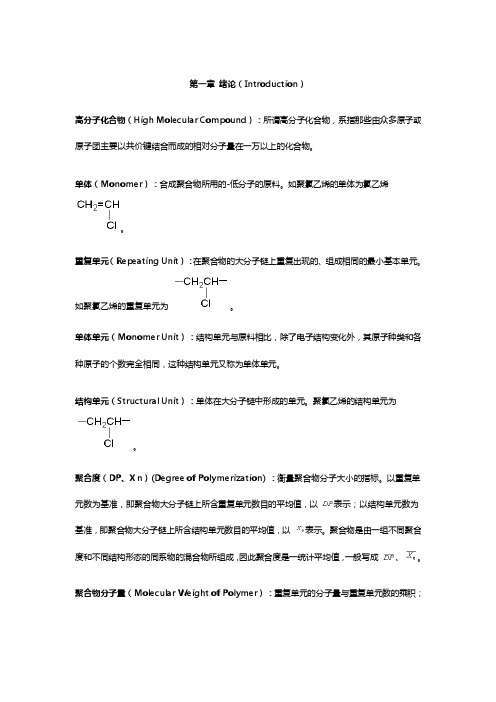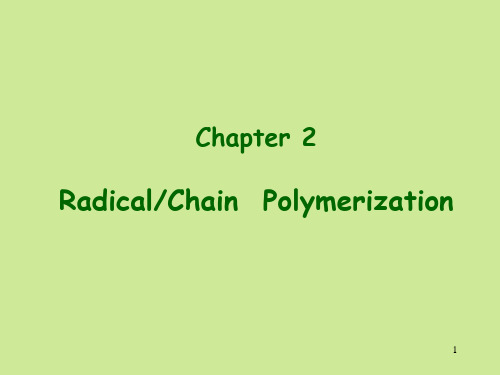高分子化学(浙江大学) polymer1 Introduction
高分子化学-1绪论课件.ppt

(3) 给重复单元命名 (4) 在重复单元名称前加“聚”
Cellulose
OH
n
+ nCH2O
Glucose
OH CH2
OH CH2 OH
n-1
phenol-formaldehyde
+ (n-1) H2O
缩聚物:(1)合成中有小分子被消除;
( 2)含有功能基(-OCO-, -NHCO-, -S-, -OCONH-,-O-, -SO2-, -OCOO-等)为聚 合物主链的一部分;
在中等聚合度阶段。
在聚合过程中,单体逐 渐减少,聚合转化率相应 增加。
延长聚合时间,主要 提高转化率,对分子量影 响较小。
聚合初期,单体几乎全 部缩聚成低聚物,以后在 由低聚物转化成高聚物, 转化率变化甚微,反应程 度逐步增加。
延长聚合时间,主要 提高分子量,而转化率变 化较少。
反应混合物仅由单体、 任何阶段,都由聚合度 高聚物及微量引发剂组成。 不等的同系物组成。
树形分子具有完美结构的聚合物。 超支化聚合物分子中存在较多缺陷, 结构完美程度差。
3、几何对称性
树形分子具有高度的几何对称性。 超支化聚合物几何对称性差。
4、端基官能团
树形分子具有大量的端基官能团,赋予树形分子具有 多功能性。 超支化聚合物也具有大量的端基官能团,但其端基官能团 并不全位于超支化聚合物的最外层。
功能高分子导论课程简介大纲-浙江大学

课程简介和教学大纲格式课程代码:09193090课程名称:功能高分子导论(An Introduction to Functional Polymers)学分:4周学时 4面向对象:高分子材料与工程专业三年级预修课程要求:高分子化学、高分子物理一、课程介绍(100-150字)(一)中文简介多学科交叉的功能高分子是高分子学科最为活跃的领域之一。
课程将从介绍功能高分子基本知识和共性问题出发,介绍功能高分子的研究方法。
并结合各领域功能高分子实例,介绍高分子材料在生命、环境、信息和能源科学中重要作用,在回答“高分子有什么用”的同时,阐述如何通过对高分子材料的设计去解决功能实现中的关键问题。
(二)英文简介Functional Polymers are one of the most active fields in polymer science. This course will systematically introduce the basic principles, common problems and experimental methods of functional polymers. This course is supposed to introduce the important applications of polymers in life science, environmental science, information science and energy science with examples of functional polymers. Students are supposed to understand “what are polymers for?”by learning to solve practical problems via the design of polymeric materials.二、教学目标(一)学习目标多学科交叉的功能高分子是近期国内外研究应用和浙江大学高分子学科最为活跃的领域之一。
高分子化学浙江大学polymer3FreeRadicalCopolymerization

Examples
Styrene Styrene + Acrylonitrile Styrene + Butadiene Styrene + Acrylonitrile+ Butadiene
PS SAN SBR ABS
Brittle, transparent, poor solvent toleration High impact, good solvent toleration High elasticity Engineering plastics
poly(ethylene-co-propylene) poly(ethylene-r-propylene) poly(ethylene-b-propylene) poly(ethylene-g-propylene) poly(ethylene-a-styrene)
乙烯-丙烯共聚物 乙烯-丙烯无规共聚物 乙烯-丙烯嵌段共聚物 乙烯-丙烯接枝共聚物 乙烯-苯乙烯交替共聚物
• r1 > 1 and r2 > 1 • Each comonomer prefers to react with others of its own kind.
• Tendency to form block copolymers.
• r1 * r2=1 • There is no preference due to the chain ends.
k11 k 21 k12 k 22
• Random incorporation of comonomers; “Ideal” copolymerization.
16
Examples
• Neither monomer homopolymerizes very well. • Forms almost perfectly alternating copolymer of high MW. • Alternating copolymerization is common in free radical
浙大高分子学科专业课及教材

以下是浙江大学高分子学科的一些专业课程及相应的教材推荐:
1. 高分子化学
- 课程内容:高分子化学的基本概念、原理和应用、高分子合成方法、高分子结构与性能等。
- 推荐教材:《高分子化学和物理导论》(作者:阎宗坤、张金凤)
2. 高聚物物理化学
- 课程内容:高分子在溶液中的物理化学行为、高分子溶液的流变学、相分离现象、高分子结晶行为等。
- 推荐教材:《高聚物物理化学》(作者:郑立平、楼同龙)
3. 高分子材料
- 课程内容:高分子材料的基本概念、种类、制备方法、性能和应用等。
- 推荐教材:《高分子材料》(作者:祁华明)
4. 高分子表征技术
- 课程内容:高分子材料结构表征的基本原理和常用方法,包括热分析技术、光谱学方法等。
- 推荐教材:《高分子物理实验》(作者:阎宗坤、钱旺)
5. 高分子加工技术
- 课程内容:高分子材料加工的基本原理和常用方法,包括挤出、注塑、吹膜、复合等。
- 推荐教材:《高分子材料加工技术》(作者:祁华明)
请注意,教材的推荐可能有所变化,建议在选课前咨询浙江大学高分子科学与工程学院或相关教师,以获取最新的课程信息和教材推荐。
高分子化学 Polymer chemistry1 绪论 Preface

The trend that engineering plastics replaces metal is developing
Engineering 1.0
plastics
40
Metals
20
plastics
0.10
10
5
60 70 80 90 2000 10
The Share in the economicsor weight of present or past in American Materials Market (Unit billion)
1970 1980 1990 2000
metal 120 132 135 141
49% 46% 41% 38%
polymer 36
53
76
96
15% 19% 23% 26%
inorgamic 38
45
53
63
material 16% 16% 16% 17%
others 49
55
60
70
20% 19% 20% 19%
•The trend that engineering plastics take the place of metal is developing, the physical volume of macromolecule has exceeded metals material. In 2000, the physical volume of the engineering plastics is similar to the metals material
The historical advance in engineering materials
高分子化学浙江大学polymer1Introduction-精选文档92页

Plastics Fibers Rubbers Coatings Adhensives Functional
General Fine
33
B. Processability
结晶
无定形
Molecules in a thermoplastic (热塑性)are held together by relatively weak intermolecular forces, so that the material softens when exposed to heat and then returns to its original condition when cooled
8
degree of polymerization 聚合度
Note that all three representations are equivalent. One usually chooses the representation that emphasizes the monomer (单体) from which the polymer was made.
* China
1970 27 4.9 5.5 38
1980 53 12 13 78
1990 107 24 23 154
2000 175(11*) 35 (6.4) 44 (0.9) 254
14
General Plastics(通用塑料)
15
Engineering plastics(工程塑料)
16
There are end groups on the chain that are different from the repeat units, but these usually represent a negligible portion of the molecule, so they are seldom drawn.
高分子化学词汇手册Polymer和高分子化学名词解释

高分子化学词汇手册Polymer1 高分子macromolecule, polymer 又称“大分子”。
2 超高分子supra polymer3 天然高分子natural polymer4 无机高分子inorganic polymer5 有机高分子organic polymer6 无机-有机高分子inorganic organic polymer7 金属有机聚合物organometallic polymer8 元素高分子element polymer9 高聚物high polymer10 聚合物polymer11 低聚物oligomer 曾用名“齐聚物”。
12 二聚体dimer13 三聚体trimer14 调聚物telomer15 预聚物prepolymer16 均聚物homopolymer17 无规聚合物random polymer18 无规卷曲聚合物random coiling polymer19 头-头聚合物head-to-head polymer20 头-尾聚合物head-to-tail polymer21 尾-尾聚合物tail-to-tail polymer22 反式有规聚合物transtactic polymer23 顺式有规聚合物cistactic polymer24 规整聚合物regular polymer25 非规整聚合物irregular polymer26 无规立构聚合物atactic polymer27 全同立构聚合物isotactic polymer 又称“等规聚合物”。
28 间同立构聚合物syndiotactic polymer 又称“间规聚合物”。
29 杂同立构聚合物heterotactic polymer 又称“异规聚合物”。
30 有规立构聚合物stereoregular polymer, tactic polymer 又称“有规聚合物”。
31 苏型双全同立构聚合物threo-diisotactic polymer32 苏型双间同立构聚合物threo-disyndiotactic polymer33 赤型双全同立构聚合物erythro-diisotactic polymer34 赤型双间同立构聚合物erythro-disyndiotactic polymer35 全同间同等量聚合物equitactic polymer36 共聚物copolymer37 二元共聚物binary copolymer38 三元共聚物terpolymer39 多元聚合物multipolymer40 序列共聚物sequential copolymer41 多层共聚物multilayer copolymer42 多相聚合物multiphase polymer43 统计[结构]共聚物statistical copolymer44 无规共聚物random copolymer45 交替共聚物alternating copolymer46 周期共聚物periodic copolymer47 梯度共聚物gradient copolymer48 嵌段共聚物block copolymer 又称“嵌段聚合物(block polymer)” 。
第1章概述高分子化学-资料

上一页 下一页
Polymer Chemistry
橡胶:一种具有可逆形变的高弹性材料。 塑料:可加工成型的刚性或热塑性材料。 3) 按用途和性能 纤维:纤细而柔软的丝状物,长径比>100。 黏合剂:具有良好胶接能力的物质。 涂料:一种涂布于物体表面能结成坚韧保护膜的物质。 功能性高分子:主链或侧链上带有反应性功能基团,并具有特殊物
1)按相对分子 低聚物:物理性能随重复单元数的增减而变化
质量大小
齐聚物:相对分子质量极低, 不具备高分子特性的缩合
物。现称为低聚物.
高聚物:聚合物一系列性能不随重复单元数增减而
变化
2) 按单体 均聚物:由一种单体聚合而成;PE/PVC/PS 单元 共聚物:两种以上单体单元组成. ABS/SBS/EVA/EPR/EPDM
技术、航空航天和导弹技术、激光技术、纳米技术。材料科 学是当今世界科学技术的带头学科之一。 徐光宪. 21世纪是信息科学、合成化学和生命科学共同繁荣的 世纪.化学通报,2019,66(1)ymer Chemistry
*材料科学:金属材料、无机(非金属)材料、高分子材料和复合 材料 1.2 高分子材料对国民经济发展所起的作用
的是电子结构或电子状态,这样的重复单元即为单体单元。
* PE、PVC、PS、PP 、PTFE的重复单元与单体单元相同。分
别为-CH2-CH2-、 -CH2-CHCl-、-CH2-CHФ-、 -CH2-CHCH3-、
-CF2-CF2- 。
O
O
H—[—OCH2CH2O—C—
—C—]n— OH
PET
结构单元
第三节 (高分子)材料科学的建立
1 高分子(材料)科学的建立 实践 理论 再实践 再理论 在基础的化学一级学科中,按学科分类列为二级学科。它
浙江大学高分子化学(潘祖仁)名词解释

第一章绪论(Introduction)高分子化合物(High Molecular Compound):所谓高分子化合物,系指那些由众多原子或原子团主要以共价键结合而成的相对分子量在一万以上的化合物。
单体(Monomer):合成聚合物所用的-低分子的原料。
如聚氯乙烯的单体为氯乙烯。
重复单元(Repeating Unit):在聚合物的大分子链上重复出现的、组成相同的最小基本单元。
如聚氯乙烯的重复单元为。
单体单元(Monomer Unit):结构单元与原料相比,除了电子结构变化外,其原子种类和各种原子的个数完全相同,这种结构单元又称为单体单元。
结构单元(Structural Unit):单体在大分子链中形成的单元。
聚氯乙烯的结构单元为。
聚合度(DP、X n)(Degree of Polymerization) :衡量聚合物分子大小的指标。
以重复单元数为基准,即聚合物大分子链上所含重复单元数目的平均值,以表示;以结构单元数为基准,即聚合物大分子链上所含结构单元数目的平均值,以表示。
聚合物是由一组不同聚合度和不同结构形态的同系物的混合物所组成,因此聚合度是一统计平均值,一般写成、。
聚合物分子量(Molecular Weight of Polymer):重复单元的分子量与重复单元数的乘积;或结构单元数与结构单元分子量的乘积。
数均分子量 (Number-average Molecular Weight):聚合物中用不同分子量的分子数目平均的统计平均分子量。
,N i:相应分子所占的数量分数。
重均分子量(Weight-average Molecular Weight):聚合物中用不同分子量的分子重量平:相应的分子所占的重量分数。
均的统计平均分子量。
,W粘均分子量(Viscosity-average Molecular Weight):用粘度法测得的聚合物的分子量。
分子量分布(Molecular Weight Distribution, MWD ):由于高聚物一般由不同分子量的同系物组成的混合物,因此它的分子量具有一定的分布,分子量分布一般有分布指数和分子量分布曲线两种表示方法。
高分子化学名词解释精品(精)

高分子化学名词解释第一章绪论(Introduction)1、高分子化合物(High Molecular Compound):所谓高分子化合物,系指那些由众多原子或原子团主要以共价键结合而成的相对分子量在一万以上的化合物。
2、单体(Monomer):合成聚合物所用的-低分子的原料。
如聚氯乙烯的单体为氯乙烯3、重复单元(Repeating Unit):在聚合物的大分子链上重复出现的、组成相同的最小基本单元。
4、结构单元(Structural Unit):单体在大分子链中形成的单元。
5、单体单元(Monomer Unit):结构单元与原料相比,除了电子结构变化外,其原子种类和各种原子的个数完全相同,这种结构单元又称为单体单元。
6、聚合度(DP、X n)(Degree of Polymerization) :衡量聚合物分子大小的指标。
以重复单元数为基准,即聚合物大分子链上所含重复单元数目的平均值;以结构单元数为基准,即聚合物大分子链上所含结构单元数目的平均值。
7、聚合物分子量(Molecular Weight of Polymer):重复单元的分子量与重复单元数的乘积;或结构单元数与结构单元分子量的乘积。
8、数均分子量M n(Number-average Molecular Weight):聚合物中用不同分子量的分子数目平均的统计平均分子量。
9、重均分子量M w(Weight-average Molecular Weight):聚合物中用不同分子量的分子重量平均的统计平均分子量。
10、粘均分子量M v(Viscosity-average Molecular Weight):用粘度法测得的聚合物的分子量。
M w>M v>M n11、分子量分布(Molecular Weight Distribution, MWD ):由于高聚物一般由不同分子量的同系物组成的混合物,因此它的分子量具有一定的分布,分子量分布一般有分布指数和分子量分布曲线两种表示方法。
高分子化学课程简介(精)

高分子化学课程简介
课程名称:高分子化学/ Polymer Chemistry
课程代码:04231003
课程性质:专业拓展/选修
学时/学分:48/3.0
开课部门:生物与化学工程学院
适用专业:化学工程与工艺、精细化工、高分子材料
先修课程:高等数学、无机及分析化学、有机化学、物理化学
课程主要内容:“高分子化学”是研究聚合物合成与反应的一门学科。
本课程系统讲授高分子聚合物基本概念,逐步聚合、自由基聚合、自由基共聚、离子
聚合与配位聚合等聚合反应机理、聚合方法、聚合物的化学反应;并以
典型聚合物的结构、性能及合成方法为核心,讲究理论性和应用性的结
合,既注重理论知识的系统性、全面性,又注重实际应用的讲解。
通过
本课程学习,让学生系统、扎实地掌握高分子化学较全面的知识,了解
高分子化学的基本原理、基本理论、简单的生产工艺过程。
着重掌握各
类高分子化合物的化学结构、合成原理、基本控制理论、常用合成方法、
一般生产工艺过程和用途,同时了解高分子合成反应中的常见问题和一
般处理方法等。
培养学生具有高分子化合物制备、性能的基本知识和技
能,为其今后在高分子相关领域工作和研究奠定坚实基础。
参考书:
1.潘祖仁主编,《高分子化学》,第四版,中国科学技术大学出版社,2007年1月
2.林尚安主编,《高分子化学》,化学工业出版社,2001年5月。
多媒体教学:是
执笔人:朱春凤
审核人:
审批人:
- 1 -。
高分子化学名词解释

高分子化学名词解释高分子化学是研究和应用聚合物的化学学科,涉及到大量的专业术语。
在本文中,我将为您解释一些常见的高分子化学名词。
1. 聚合物(Polymers):聚合物是由许多重复单元(称为聚合单元)组成的大分子化合物。
聚合单元通过化学键连接在一起,形成线性、支化或网络结构。
聚合物可以是天然的(如蛋白质、纤维素)或合成的(如塑料、橡胶)。
2. 单体(Monomers):单体是聚合反应的起始物,可以通过化学反应与其他单体结合形成聚合物。
单体的化学结构和反应选择决定了聚合物的性质。
3. 聚合度(Degree of Polymerization):聚合度是聚合物中聚合单元的数量,即聚合物链上的单体个数。
聚合度越高,聚合物链越长。
4. 高分子量(Molecular Weight):高分子量是聚合物链的总质量。
高分子量通常与较长的聚合链相关,对聚合物的物理和化学性质有重要影响。
5. 高分子包容体(Polymer Conformation):聚合物可以在溶液中呈现不同的构象,如线性、螺旋、球形等。
高分子包容体直接影响聚合物的溶解性、流变性和各种物理性质。
6. 聚合反应(Polymerization):聚合反应是将单体转化为聚合物的化学过程。
根据反应机制的不同,聚合反应可以分为链聚合、环化聚合、缩聚聚合等。
7. 共聚物(Copolymers):共聚物是由两种或多种不同类型的单体按一定比例聚合而成的聚合物。
共聚物的存在可以改变聚合物的性质,达到所需的特定功能。
8. 交联聚合物(Crosslinked Polymers):交联聚合物由三维网状结构连接的聚合物链组成。
交联聚合物具有更高的强度和耐热性,广泛应用于橡胶、涂料和粘合剂等领域。
9. 热塑性聚合物(Thermoplastic Polymers):热塑性聚合物可以在加热时软化,并在冷却后保持其形状。
热塑性聚合物可以反复加热和重塑,广泛应用于塑料制品制造。
10. 热固性聚合物(Thermosetting Polymers):热固性聚合物在初次加热固化后,不会软化或融化,无法再次重塑。
高分子化学(浙江大学) polymer2-1 Radical Chain Polymerization

3.3 Reactions of Radical Polymerization
Initiation (Thermal 热分解) Ea =105-150 KJ/mol
AIBN
fast
Ea =20-34 KJ/mol
Initiator breaks down smoothly to generate a low, steady-state (稳态) concentration of radicals.
B. 1,2-disubstituted disfavor for polymerization (electronic and steric)
C. tri- and tetra-substituted vinyl monomers normally impossible, except fluoroalkene Polymerization ability is mainly determined by the electron effect, steric effect should be also considered when the substitute is large.
The Steady State (稳态)
• Initiation is relatively slow but continuous. • Termination speeds up as active radical concentration builds. • Termination removes (kills) active radicals.
– if both X and Y are electron donor/acceptor, CH2=CH(CN)2 (anion), CH2=CH(CH3)2 (cation) – if X and Y are different, determined by stronger group
- 1、下载文档前请自行甄别文档内容的完整性,平台不提供额外的编辑、内容补充、找答案等附加服务。
- 2、"仅部分预览"的文档,不可在线预览部分如存在完整性等问题,可反馈申请退款(可完整预览的文档不适用该条件!)。
- 3、如文档侵犯您的权益,请联系客服反馈,我们会尽快为您处理(人工客服工作时间:9:00-18:30)。
h
2
Schedule
• Chapter 1 Introduction
3 hr
• Chapter 2 Radical Polymerization
12
• Chapter 3 Radical Copolymerization 6
• Chapter 4 Polymerization Process
3
h
3
29
Polymer Chemistry
Content
• Polymer and its structure • Polymerization mechanism and kinetics • Polymer reaction
Frontier
• Novel synthetic method and polymer family • Design and control on the chain structure of polymer • Recycle of polymer
h
16
Synthetic rubber, elastomer (合成橡胶和弹性体)
h
17
Synthetic fibers(合成纤维)
Kevlar Vest
h
18
Fine polymers(精细高分子)
h
19
Functional polymers(功能高分子)
h
20
Plastics vs Steel
h
12
In Nature
Cellulose, Starch, DNA, Protein
甲壳素 壳聚糖
h
13
Synthetic Materials
Annual Production of Polymer Materials (million ton)
Year Plastics Synthetic fiber Synthetic rubber Total
• Synthetic
– Various families and large quantities, but less precise
h
28
1.5 Polymer Disciplines
Polymer science
h
Polymer chemistry Polymer physics Polymer material Polymer process Polymerization engineering
h
5
1. Fundamental Concepts
h
6
1.1 What is a polymer?
A polymer is a large molecule comprised of repeating structural units joined by covalently bonds.
(Hermann .Staudinger,1924)
• Element polymer– no carbon in backbone
• The repeat units can all be identical, in which case the compound is a homopolymer(均聚物).
h
25
• If the repeat units are different, the result is a copolymer(共聚物). Consider a copolymer made from just two ingredients: the two can be sequenced along the backbone in various modes.
* China
1970 27 4.9 5.5 38
1980 53 12 13 78
1990 107 24 23 154
2000 175(11*) 35 (6.4) 44 (0.9) 254
h
14
General Plastics(通用塑料)
h
15
Engineering plastics(工程塑料)
• The way people classify polymers depends their experience.
• Widely used historical terms or trade names lacking information content.
h
32
A: Application
Note that all three representations are equivalent. One usually chooses the representation that emphasizes the monomer (单体) from which the polymer was made.
There are end groups on the chain that are different from the repeat units, but these usually represent a negligible portion of the molecule, so they are seldom drawn.
h
9
Polymer(聚合物) vs Macromolecule(大分子)
Macromolecule
Polymer
molecule with high molecule weight molecule comprised of repeating unit
Sample
Polyethylene DNA Protein
交替
嵌段 无规
接枝
h
26
• The chain itself can have many different topologies
线型 支化
环状 macrocycle
交联
h
dendrimer 树枝状27
1.4 Production of polymer
• Nature
– precise control on molecular structure Starch, Natural rubber, Polysaccharides(多糖)
Reference Books
• 冯新德,《高分子合成化学》 化学工业出版社,1980。 • 林尚安 等,《高分子化学》科学出版社,2000。 • 赵德仁,张慰盛,《高聚物合成工艺学》化学工业出版社,
1997。
• Malcolm P. Stevens “Polymer Chemistry, an Introduction”, 3rd ed., Oxford University Press, 1999
h
21
Energy Consumption
h
22
Green or not?
Ideal material
polyolefin
h
paper
glass
aluminium
23
1.3. Definitions
CH2CH n Cl
O
O
NH(CH2)6NHC(CH2)4C n
structural unit
结构单元
several times their unstretched length and which rapidly return to their
original dimensions whehn the applied stress is released.
34
C: Chemical Composition
h
24
Polymers are large molecules. Fortunately, they are not random collections of atoms; if this were the case, they would be impossible to study.
Polymers are built up from smaller molecules (monomers), and therefore possess a characteristic chain structure consisting of multiple repeat units that are related chemically
Organic • Natural
– Polysaccharides
– Proteins – Polyisoprene • Synthetic – Plastics – Fibers – Rubbers – Adhesive – Coatings –…
11
Polymer is everywhere
repeating unit
重复单元
The degree of polymerization (DP) in a polymer molecule is the number, n, of repeating units in the polymer chain.
Mw DP mrepeautinnigt
• Carbon-chain polymer –backbone composed of carbon atom
CCCCC
• Hetero chain polymer –composed of both carbon and other atoms, e.g. O, N, S, P etc.
CCOCCO
• George Odian, “Principles of Polymerization”, 2nd ed., John Wiley &Sons, Inc., New York, 1981.
